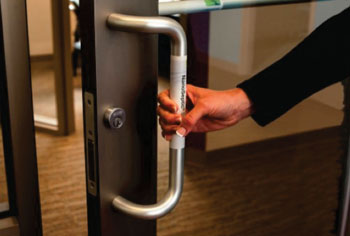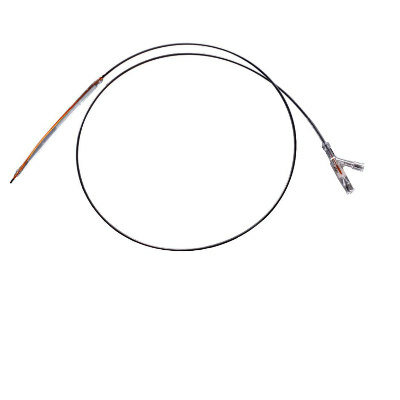Nanoscale Disruptive Technology Kills Pathogens on Touch
|
By HospiMedica International staff writers Posted on 10 Mar 2015 |

Image: A NanoSeptic self-cleaning surface door handle (Photo courtesy NanoTouch Materials).
Innovative surface technology kills pathogens in an environmentally conscious way, without generating resistant microbes which are difficult to treat.
NanoSeptic self-cleaning surfaces are composed of antimicrobial components that provide a non-leaching, self-cleaning surface that constantly kills bacteria, viruses, and fungi utilizing molecularly bonded nanotechnology and a light-powered catalytic oxidation process. The surface is also hydrophilic, so that water, oils, dirt, and other contaminants are actively shed. The surfaces are available in standard sizes for door push pads, door handle wraps, door push bar pads, equipment and cart handle wraps, and even disposable mouse pads. The adhesive wrappings are peeled off and replaced periodically.
Maintenance includes routine cleaning with soap and water or stronger cleansers, and does not affect the efficacy of the surface. While the surfaces are self-cleaning at a microscopic level, they can still become soiled or stained if exposed to coffee, wine, or suchlike, but will continue to function as long as no abrasive products that can physically wear or damage them are used. The NanoSeptic self-cleaning surfaces are manufactured by NanoTouch Materials (Forest, VA, USA), and have an effective life in the healthcare setting of 90 days, as long as he surface is not worn.
“When it comes to healthcare, we’re thrilled that our approach aligns with the Hippocratic Oath which states that doctors should ‘first, do no harm,’” said Dennis Hackemeyer, co-founder of NanoTouch Materials. “Since the NanoSeptic surface doesn’t use chemicals, poisons, or heavy metals, we aren’t adding any toxins to the environment, and it doesn’t contribute to antimicrobial resistance.”
Related Links:
NanoTouch Materials
NanoSeptic self-cleaning surfaces are composed of antimicrobial components that provide a non-leaching, self-cleaning surface that constantly kills bacteria, viruses, and fungi utilizing molecularly bonded nanotechnology and a light-powered catalytic oxidation process. The surface is also hydrophilic, so that water, oils, dirt, and other contaminants are actively shed. The surfaces are available in standard sizes for door push pads, door handle wraps, door push bar pads, equipment and cart handle wraps, and even disposable mouse pads. The adhesive wrappings are peeled off and replaced periodically.
Maintenance includes routine cleaning with soap and water or stronger cleansers, and does not affect the efficacy of the surface. While the surfaces are self-cleaning at a microscopic level, they can still become soiled or stained if exposed to coffee, wine, or suchlike, but will continue to function as long as no abrasive products that can physically wear or damage them are used. The NanoSeptic self-cleaning surfaces are manufactured by NanoTouch Materials (Forest, VA, USA), and have an effective life in the healthcare setting of 90 days, as long as he surface is not worn.
“When it comes to healthcare, we’re thrilled that our approach aligns with the Hippocratic Oath which states that doctors should ‘first, do no harm,’” said Dennis Hackemeyer, co-founder of NanoTouch Materials. “Since the NanoSeptic surface doesn’t use chemicals, poisons, or heavy metals, we aren’t adding any toxins to the environment, and it doesn’t contribute to antimicrobial resistance.”
Related Links:
NanoTouch Materials
Latest Critical Care News
- Bioadhesive Strategy Prevents Fibrosis Around Device Implants on Peripheral Nerves
- Miniature Non-Invasive Robotic Catheters to Improve Infertility Treatments
- Stick-On Patch Monitors Baby's Movements In Utero
- EEG-Based AI Technology Accurately Diagnoses Alzheimer’s and Dementia
- Robot Lymphatic System Paves Way for Self-Powered Wearables and Machines
- Focused Ultrasound Technique Successfully Treats Pediatric Brain Cancer
- Nasal Drops Fight Brain Tumors Noninvasively
- AI Helps Optimize Therapy Selection and Dosing for Septic Shock
- Glowing Bacteria ‘Pills’ for Detecting Gut Diseases Could Eliminate Colonoscopies
- Skin-Permeable Polymer Patch Delivers Insulin Non-Invasively Through Skin
- Nanogel Technology Almost 100% Effective in Destroying Drug-Resistant Bacteria Within Hours
- Wearable Ultrasound Sensor Delivers Noninvasive Treatment Without Surgery
- Gel-Free ECG System to Transform Heart Health Diagnosis
- Biodegradable Patch Repairs Damaged Tissue After Heart Attack
- Magnetically Guided Microrobots to Enable Targeted Drug Delivery

- Smart Nanomaterials Detect and Treat Traumatic Brain Injuries Simultaneously
Channels
Surgical Techniques
view channel
Catheter-Based Procedures Offer Less Invasive Option for Treatment of Valvular Disease
Valvular heart disease, caused by tight or leaky valves between heart chambers, affects up to 10% of older adults and leads to more than 120,000 deaths globally each year. Traditional open-heart surgery... Read moreLaparoscopic Surgery Improves Outcomes for Severe Newborn Liver Disease
Biliary atresia is a rare but life-threatening liver condition in newborns that blocks bile flow and leads to progressive liver damage if not treated early. Surgery is typically performed within the first... Read morePatient Care
view channel
Revolutionary Automatic IV-Line Flushing Device to Enhance Infusion Care
More than 80% of in-hospital patients receive intravenous (IV) therapy. Every dose of IV medicine delivered in a small volume (<250 mL) infusion bag should be followed by subsequent flushing to ensure... Read more
VR Training Tool Combats Contamination of Portable Medical Equipment
Healthcare-associated infections (HAIs) impact one in every 31 patients, cause nearly 100,000 deaths each year, and cost USD 28.4 billion in direct medical expenses. Notably, up to 75% of these infections... Read more
Portable Biosensor Platform to Reduce Hospital-Acquired Infections
Approximately 4 million patients in the European Union acquire healthcare-associated infections (HAIs) or nosocomial infections each year, with around 37,000 deaths directly resulting from these infections,... Read moreFirst-Of-Its-Kind Portable Germicidal Light Technology Disinfects High-Touch Clinical Surfaces in Seconds
Reducing healthcare-acquired infections (HAIs) remains a pressing issue within global healthcare systems. In the United States alone, 1.7 million patients contract HAIs annually, leading to approximately... Read moreHealth IT
view channel
EMR-Based Tool Predicts Graft Failure After Kidney Transplant
Kidney transplantation offers patients with end-stage kidney disease longer survival and better quality of life than dialysis, yet graft failure remains a major challenge. Although a successful transplant... Read more
Printable Molecule-Selective Nanoparticles Enable Mass Production of Wearable Biosensors
The future of medicine is likely to focus on the personalization of healthcare—understanding exactly what an individual requires and delivering the appropriate combination of nutrients, metabolites, and... Read moreBusiness
view channel
Philips and Masimo Partner to Advance Patient Monitoring Measurement Technologies
Royal Philips (Amsterdam, Netherlands) and Masimo (Irvine, California, USA) have renewed their multi-year strategic collaboration, combining Philips’ expertise in patient monitoring with Masimo’s noninvasive... Read more
B. Braun Acquires Digital Microsurgery Company True Digital Surgery
The high-end microsurgery market in neurosurgery, spine, and ENT is undergoing a significant transformation. Traditional analog microscopes are giving way to digital exoscopes, which provide improved visualization,... Read more
CMEF 2025 to Promote Holistic and High-Quality Development of Medical and Health Industry
The 92nd China International Medical Equipment Fair (CMEF 2025) Autumn Exhibition is scheduled to be held from September 26 to 29 at the China Import and Export Fair Complex (Canton Fair Complex) in Guangzhou.... Read more














